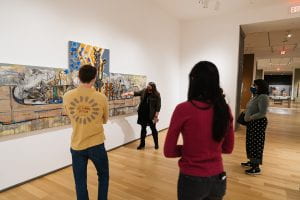One of the first things you discover as a visitor services guide is that anyone who enters the museum will quickly find several beautiful, fascinating, thought-provoking, and socially conscious works of art—there is no shortage of them within these walls. Attempting to select a single favorite is practically futile. However, if I were forced to choose, I would say that I find myself drawn to the pieces and installations that provide social and philosophical commentary.

The Kaish Gallery serves as our main entry point and typically showcases contemporary works that engage social issues and encourage open dialogue. As part of an initiative to be more equitable and socially conscious, museum staff chose during the 2016–19 renovation to make this gallery both the first and last encounter visitors have. Venturing further into the museum, you find yourself stepping back in time as you approach the original entry point, Kim Gallery, which displays art from ancient cultures. The ongoing exhibition in this gallery, Global Cultures: Ancient and Premodern, sparks similar conversations to those in Kaish Gallery, though the works do so in a less obvious fashion.

On the surface, Kim is practically the antithesis of Kaish. Most of the works on view were made by unknown artists and range from hundreds to thousands of years old. The earliest object on view in Kim, an ancient Chinese bronze wine vessel, dates from 1300 to 1050 BCE, whereas the most recent work is an Islamic tile panel from 1604. The art and artifacts themselves provide no commentary on current social concerns. However, a contextual analysis of specific pieces in this exhibition allows for a nuanced interpretation, especially when considered in conjunction with works like Jaune Quick-to-See Smith’s The Rancher, acquired by the Hood in 2005, and Trade Canoe: Forty Days and Forty Nights, lent to the museum by Judith Liff Barker and Joseph N. Barker, Class of 1966, and the Judy and Noah Liff Foundation. This juxtaposition became obvious to me when both works were on view in Kaish Gallery as part of an exhibition of Smith’s work titled Trade Canoe: Forty Days and Forty Nights in 2021. In her work, Jaune Quick-to-See Smith addresses colonization, the commodification of Native Americans and their imagery, and the pervasive stereotypes of Indigenous peoples.

Located just a stone’s throw away in the Kim Gallery are the Hood’s Assyrian reliefs, six gypsum panels that were carved around 883–859 BCE for the walls of the Northwest Palace of Ashurnasirpal II. The imagery and inscriptions on these hulking, eight-foot-tall reliefs depict the might and accomplishments of the king, reaffirming his divine right to rule. The Northwest Palace was located in the ancient Assyrian city of Nimrud, in what is now Iraq. The site was excavated in 1845–47, and the reliefs were excised from the walls in sections before being distributed globally by missionaries to various colleges and museums. Dartmouth’s six reliefs joined the College’s collection in 1856, over one hundred years before the Hood Museum was constructed. These works are ideal companions to Jaune Quick-to-See Smith’s paintings because in many ways they testify to the power of colonialism and the predominantly Western, white proclivity toward claiming, commodifying, and in some cases demolishing other cultures and their iconography. The very presence of the Assyrian reliefs in museums like the Hood underlines the greater social structures of colonialism and capitalism that also permeate Jaune Quick-to-See Smith’s paintings.

In Smith’s The Rancher, the central figure, a Native American man in ceremonial dress, is nearly obscured by dripping paint and familiar company logos including Krispy Kreme, Purina, and Hecho en USA (Made in USA). The logos are vibrant and visually dominate the canvas, overshadowing the murky image of the man in the background, crafting an eerie parallel to how indigenous peoples’ imagery, voices, and interests are too often co-opted and misrepresented by corporations. Similarly, in Trade Canoe, Smith employs a mixture of Salish imagery and Judeo-Christian iconography—specifically, themes of Noah’s Ark alongside the characters from Salish creation stories—to provide a critique of current social and environmental issues while also offering hope for the future. Across her work, Smith repurposes Western religious, historical, and cultural iconography and juxtaposes these images with depictions of Indigenous culture, creating a tension that challenges the categorization of Western colonial influences as “normal” and Indigenous culture as “other.” In so doing, Jaune Quick-to-See Smith reclaims and reappropriates Indigeneity. Her use of well-known logos and recognizable Indigenous imagery demonstrates the ways in which Indigenous peoples and their imagery and iconography are commodified and used in marketing to appeal to a predominantly white customer base through exoticized depictions of Indigenous cultures. Such depictions highlight aspects of these cultures that have been amalgamated into imaginary spokespeople predicated on supposed characteristics and stereotypes. This can be seen in both historical and modern representations of Indigenous peoples.

Like the rampant use of Indigenous imagery in contemporary marketing, many museums and cultural institutions utilize images of the Assyrian reliefs and other artifacts to advertise their collection and exhibitions in their promotional materials. These objects, taken as spoils in the name of the greater colonial project, were often defaced in the process of acquisition—much like the Assyrian reliefs—and misappropriated in the name of education or preservation. Far too many institutions continue to use these objects to market their own accomplishments and splendor rather than to call attention to their problematic history. While modern, mission-driven principles cannot always outweigh the harmful impacts of the initial acquisition, one reason why the Assyrian reliefs are able to participate in such a poignant dialogue with contemporary socially conscious artists is the Hood Museum’s active effort to address and redress the colonialist mindset that resulted in their original acquisition.
With more time, further exploration of these two exhibitions and galleries could address themes of power and privilege that emerge with the creation and consumption of art, as well as the ways in which in which imagery like that in Smith’s work influences our perceptions and beliefs about individuals and cultures. Here, I hope that I have begun to highlight the ways in which our exhibitions speak to each other, even when appearances suggest disparate subjects. Alone, they are entrancing exhibitions; together, however, they highlight social and philosophical issues in ways that both challenge and enlighten visitors’ understanding of the past. While I may not be able to select a favorite aspect of the museum or its collection, I greatly enjoy seeing the ways in which audiences interact with these works.
Click here for more information about the exhibition Jaune Quick-to-See Smith: Trade Canoe: Forty Days and Forty Nights, which was on view January 6–December 12, 2021, and referenced in this post.
This post was authored by: Ashley Todt, Visitor Services Guide

ABOUT THE AUTHOR
Ashley joined the Hood Museum of Art in July 2021. As a visitor services guide, she is tasked with facilitating positive visitor experiences and engagement as well as assisting with the safety and security of the building, visitors, and the art collection. She has a passion for the arts, with a specific focus on theatre and the performing arts. Between 2015 and 2020, she lived in London while studying for a BA in drama, theatre, and performance / film studies from the University of Roehampton followed by an MA in text and performance from Birkbeck, University of London. Prior to her role at the Hood Museum, Ashley has worked in the front of house departments of several performing arts organizations, including the Royal Albert Hall and the Barbican Arts Centre.

Comments